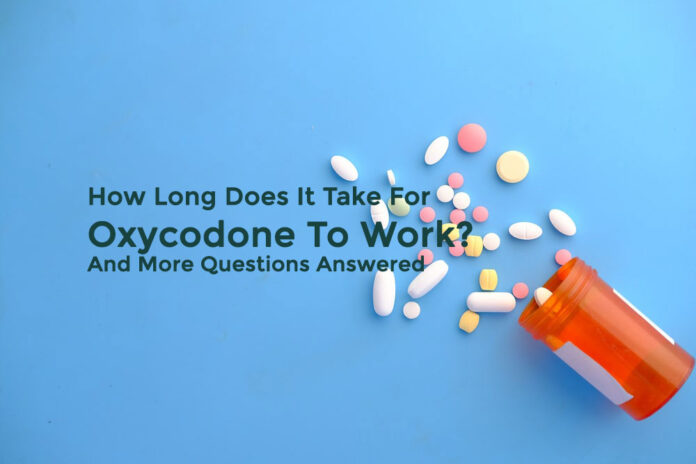Oxycodone is an opioid medication often prescribed to individuals managing pain. While it can be effective, it’s important to be aware of all aspects of this drug before starting a regime.
One common question people have with oxycodone is: How long does it take for oxycodone to work?
This post will dive into the details of how oxycodone works in your body, how long it lasts, who it is prescribed to, and answer those wondering, “how long does it take for oxycodone to work?”
What is oxycodone?
Oxycodone is a powerful opioid pain medication used to treat chronic, severe pain in patients resistant to other types of analgesic treatments. The medication works by targeting the brain and nervous system to block pain signals from reaching the brain, thereby reducing pain sensation. Oxycodone is available in both short-acting and long-acting formulations, and is often used alongside other pain medications to provide long-lasting pain relief.
How long does it take for oxycodone to work?
The amount of time for oxycodone to start working differs based on various factors including the dosage and form (immediate release vs. controlled release). When taking immediate release oral oxycodone, the body processes it quickly, so its effects can usually be experienced within 30 minutes of taking the medication.
After around 30-60 minutes, peak effects of the medication are experienced. Since everyone’s body is different, the onset of action may differ for each person. Patients should always consult their doctor regarding the proper dosage and timing for their oxycodone prescription.
Who can be prescribed oxycodone?
Oxycodone is primarily prescribed to patients who are suffering from chronic, severe pain due to medical conditions such as cancer, degenerative arthritis, or terminal illness. Doctors carefully evaluate these patients’ medical histories and condition before prescribing oxycodone, as well as closely monitor the patient’s usage to avoid any potential addiction or overdose.
What makes oxycodone addictive?
The reason why oxycodone is addictive is that it interacts with the reward center of the brain. This area is in charge of pleasure and reward sensations, and oxycodone affects it by releasing dopamine, which induces pleasurable feelings. Over time, patients who take oxycodone may develop a tolerance to the drug’s effects on dopamine, leading them to need higher doses to feel the same relief.
This pattern can ultimately lead to addiction, which is why healthcare providers are cautious about prescribing oxycodone due to its addictive nature. They carefully evaluate its advantages and disadvantages before administering oxycodone to patients, given the growing awareness of its addictive properties.
Wrap-Up: Use This Guide Before Using Oxycodone
One reason why the question “how long does it take for oxycodone to work?” is so common is due to the intensity of the drug. Oxycodone is a powerful pain medication that should always be taken as prescribed by a healthcare practitioner. It takes up to 30 minutes for the medication to start working, and its effects can last from four to six hours. Since oxycodone is a drug with such a high risk for abuse, it is typically only prescribed for those who suffer from chronic and severe pain.
While oxycodone does provide powerful pain relief, it also can be highly habit-forming which needs to be kept in mind when using it. Taking the recommended dosage of this drug is critical to prevent adverse effects and potential abuse.
Read Also
- Why the Keto Diet Works for Some People—and Fails Dramatically for Others: An Ayurvedic Breakdown for Modern HealthcareThe keto diet has dominated weight-loss culture for years. For some people, it produces rapid fat loss, stable energy, and improved mental clarity. For others—especially those who gain weight easily—it leads to burnout, digestive distress, rebound weight gain, high cholesterol, and a metabolism that feels slower than before. Healthcare often frames this as a discipline… Read more: Why the Keto Diet Works for Some People—and Fails Dramatically for Others: An Ayurvedic Breakdown for Modern Healthcare
- How to Choose the Best Assisted Living Facility for SeniorsAre you looking for the right assisted living facility for a senior loved one? Choosing a place can feel overwhelming. There are many factors to consider, from care services to the environment. Safety, comfort, and social opportunities play important roles in daily life. Each senior has unique needs and preferences that must be met. Understanding… Read more: How to Choose the Best Assisted Living Facility for Seniors
- Burn Smart, Not Hard; Shape Burn: Clean Protein for Weight ManagementYou want to feel light, strong, and confident. You don’t want crash diets or fake promises. You need a plan that works with your body, not against it. That’s where Shape Burn comes in. You can burn fat without losing strength. You can eat better and stay full. You can manage weight in a way… Read more: Burn Smart, Not Hard; Shape Burn: Clean Protein for Weight Management
- Creatine Basics: How Much Is 5g, How Much Water You Need, and Whether Pills or Powder Work BetterIf you’ve ever walked into a supplement aisle or scrolled through fitness TikTok, you’ve probably seen people talking about creatine — usually with a shaker bottle in hand and promises of better workouts and faster gains. And honestly? They’re not wrong. Creatine is one of the most researched and effective supplements for muscle strength, recovery,… Read more: Creatine Basics: How Much Is 5g, How Much Water You Need, and Whether Pills or Powder Work Better
- Understanding Breast Cancer in Men: Key Facts and SymptomsBreast cancer is often thought of as a disease that only affects women. However, men can develop it too. Although it is less common, early detection and awareness are important. Read on to learn key facts, symptoms, and ways men can take action to protect their health. How Common Is Breast Cancer in Men? Breast… Read more: Understanding Breast Cancer in Men: Key Facts and Symptoms
- Raising Awareness: Breast Cancer Facts for Older MenBreast cancer does not affect only women, and many older men do not realize they are at risk. Because the signs can be easy to miss, many men learn about the disease only when it has progressed. Learning the basic facts now can help you stay aware and respond early. If you want to protect… Read more: Raising Awareness: Breast Cancer Facts for Older Men







